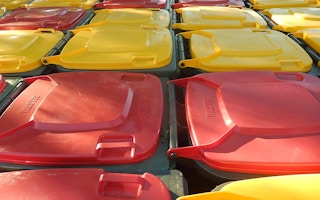Responsible batteries, “cleaner” clean energy, mobile recycling centres and better-designed buildings that accommodate rubbish trucks—these were some of the ideas suggested by waste management experts at the Australian Waste and Recycling Expo (AWRE) at the Sydney Showground last Wednesday.
Speaking at a seminar on the sidelines of the expo, Damien Giurco, director of research outcomes at the University of Technology Sydney Institute for Sustainable Future, argued that the Australian economy can grow in a more responsible fashion by adopting circular economy approaches across various industries.
The circular economy is an umbrella term for business models and industrial processes which do not generate waste but rather, reuse natural resources repeatedly.
According to the World Economic Forum, the circular economy globally could be worth US$1 trillion per year by 2025. Research co-authored by Giurco last year shows that Australia’s share of the benefits could be A$26 billion annually.
Giurco told the audience about 80 that right now, Australia needs to be more rigorous about applying circular processes. For example, as renewable energy adoption gains popularity in Australia, many buildings and products are designed to be compatible with renewable energy. But ironically, less thought is given to conserving the natural resources used in making solar panels and batteries.
He expanded on how batteries can be more responsibly processed. Recycling loops can be improved so batteries can be recovered at the end of their life cycle, and companies should also source minerals used to make batteries from countries which adopt responsible environmental and labour practices.
Other production methods which will help Australia shift towards a circular economy include additive manufacturing - which is more commonly known as 3D printing and makes it easier to recycle materials such as plastic and concrete into new products - and data analytics to maximise resource efficiency, he added.
Looking ahead, he said that recycling technology has advanced to a point where machines are compact enough to be easily transported from one point to another.
Companies could foreseeably bring recycling infrastructure to firms rather than the other way around.
“We need to be testing, exploring, failing, and trying again to develop new modes of collaboration,” he said. “This would involve the research, industry and government sectors working together.”
On its part, the New South Wales (NSW) state government said it is firmly committed to reducing waste and increasing recycling rates.
“
We need to be testing, exploring, failing, and trying again to develop new modes of collaboration.
Damien Giurco, director (research outcomes), Institute for Sustainable Futures, University of Technology Sydney
Barry Buffier, chair and chief executive officer of the NSW Environmental Protection Authority (EPA), shared state targets during a separate panel discussion at the conference.
They include: 80 per cent recycling rate for construction and demolition waste (up from 57 per cent in 2011) and 70 per cent recycling rate for municipal solid waste, compared with about 52 per cent in 2011.
To raise funds, the state government applies a levy on some waste facilities in the state. For every tonne of waste received, these facilities must pay between A$78.20 and A$135.70.
This levy has raised some A$465.7 million for the NSW government to spend on its Waste Less, Recycle More initiative. The five-year public programme includes litter prevention initiatives and holding events to collect difficult waste types such as household chemicals.
The government also wants to reduce the amount of waste generated per capita and the total amount of waste going into NSW landfills, said Buffier.
Other panellists at the conference said that one challenge facing waste management and reduction is high-density apartment living in city areas.
David Clancy, general manager of NSW Cleanaway, a waste management services provider, said that apartment blocks generate a lot of waste that are not properly separated by residents. Most building basements are also narrow and cramped, and bin trucks find it hard to get in.
The result is piles of waste on the street and lower recycling and resource recovery rates across the state, he added.
Ideally, architects and developers should design buildings that accommodate rubbish trucks, he noted. This involves paying attention to details such as basement clearance heights, turning circles for vehicles in carparks, and the location of bin rooms.
Jenny Campbell, director of Encycle Consulting, suggested coming up with a set of clear, consistent construction guidelines for engineers and architects on waste management needs, which is currently lacking in the industry.
Construction professionals should also factor in waste management needs into the early stages of design, she said, adding that this would require city councils, waste companies, and property developers to work much more closely with one another.
“Everyone needs to collaborate better and learn from each other,” she added.

















